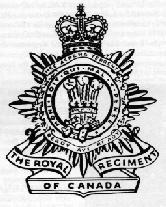|
|

They shall grow not old, as we that are left grow old

|
|
The Royal Regiment of Canada

Armorial Description
An eight-pointed star surmounted by the Crown; superimposed upon the star the
garter with the motto HONI SOIT QUI MAL Y PENSE flanked by sprays of maple
leaves; below the garter a scroll inscribed READY AYE READY; above the garter
a scroll inscribed NEC ASPERA TERRANT; within the garter, the badge of the
Heir Apparent (three feathers enfiled by a coronet with a scroll inscribed ICH
DIEN. The whole resting upon a scroll bearing the designation THE ROYAL
REGIMENT OF CANADA.
Official Abbreviation: R Regt C
Motto: Ready Aye Ready, and Nec Aspera Terrant (Difficulties do not
daunt)
Battle Honours (46)
Early History
FISH CREEK
BATOCHE
NORTH-WEST CANADA, 1885
SOUTH AFRICA, 1899-1900
First World War
YPRES, 1915, '17
Gravenstafel
Arleux
ST. JULIEN
Hill 70
Scarpe, 1917, '18
FESTUBERT, 1915
PASSCHENDAELE
MOUNT SORREL
SOMME, 1916, '18
AMIENS
Drocourt-Queant
Pozieres
Flers-Courcelette
HINDENBURG LINE
Canal du Nord
Ancre Heights
Cambrai, 1918
ARRAS, 1917, '18
VIMY, 1917
Pursuit to Mons
France and Flanders, 1915-18
Second World War
DIEPPE
Woevsdrecht
Bourguebus Ridge
FAUBOURG DE VAUCELLES
VERRIERES RIDGE -- TILLY-LA-CAMPAGNE
THE HOCHWALD
FALAISE
SOUTH BEVELAND
THE RHINELAND
Falaise Road
Goch-Calcar Road
Clair Tizon
Foret de la Londe
Dunkirk, 1944
THE SCHELDT
XANTEN
TWENTE CANAL
Groningen
Oldenburg
North-West Europe, 1942, 1944-45
Order of Precedence: 6
Options:
Go back to the Infantry Regiments page.
Go back to the Army home page.
|
|
|
| |
BTDT : Been There, Done That. The person that has "been there, done that" in real time. Not someone from a school or course that has only learned the basics, in a class or by theory, but has lived the experience for real.
» Download the iPhone/iPad Military Terms app! «
|
|
| |
December 23
1900: The Second (Special Service) Battalion, The Royal Canadian Regiment arrives in Halifax from South Africa and is disbanded
1935: Italians begin using mustard gas in Ethiopia
» Download the iPhone/iPad Military History app! «
|
|
